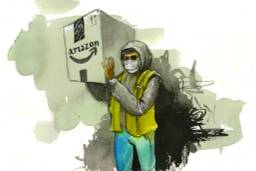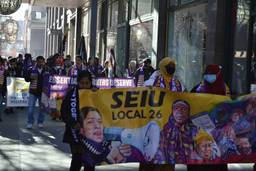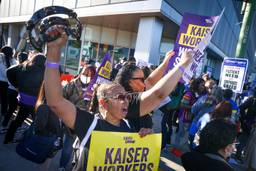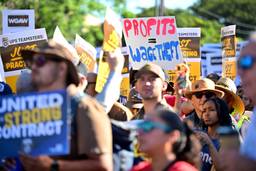On September 23, in Taiyuan, China, about 2,000 workers erupted in a burst of anger, leaving a factory compound scarred with broken glass and flames. But the trouble was just as quickly extinguished, and it’s now back to business as usual at Foxconn, one of the world’s premier electronics makers.
While details of the fracas, which left many injured, are still emerging, the pattern is familiar: the uprising reflected increasing unrest throughout China’s manufacturing workforce, as well as the intense workplace stress that has become a hallmark of the Foxconn empire since a string of well-publicized worker suicides in 2010. The question now is whether this tension will ultimately be channeled into direct action that might yield long-term changes in the global production chain that manufactures our prized gadgets.
In contrast to the despair workers displayed in 2010, the riot represents an angrier response to the everyday miseries of assembly-line work, which is mind-numbing, exhausting, and low-paid, and which largely feeds off of a steady flow of migrants seeking any kind of stable work in the city.
One account posted on sina.com (translation via U.S.-based China Labor Watch) suggests the violence began with a scuffle involving migrant workers and security forces, and quickly metastisized once “a guard stabbed a worker from Shandong and seriously wounded him”:
At this moment, all workers from Shandong were enraged and started to fight the guards. At first the guards were aggressive since there were hundreds of them. However, as more and more workers from Shandong gathered, the guards were overpowered and beaten. Realizing that they were outnumbered, the guards started to run away.
Soon, others joined in: “a lot of [workers] lost their minds and smashed everything they saw, including the supermarket and internet cafe on the campus.” Photographs of the scene appear to confirm this.
But neither the exact extent of the violence nor how many participated are known. Predictably, Foxconn has denied damage to the facilities, according to the New York Times. At the same time, with thousands of police reportedly sent in to suppress the protests, there should be some concern about the authorities invoking workplace violence as a pretext for a wider anti-worker crackdown.
Geoffrey Crothall, spokesperson of the Hong Kong-based China Labour Bulletin (CLB), tells Working In These Times via email:
[T]he vast majority of work disputes, strikes and protests are peaceful. Even if police are called in, most disputes do not escalate into violence. That said, given the fact that many workers have to suppress anger and resentment against their employer because there are no formal channels for resolving grievances, we should not be surprised when violence does break out.
The riot suggests that while workers may not yet have a clear agenda for improving working conditions, they are growing more conscious of the power of collective action. Their rage is further justified by the police reaction, indicating local authorities’ alignment to a powerful multinational corporation.
A translated online dialogue published by CLB indicates that long before the clash, workers were suffering from oppressive conditions:
A worker, who said he had been employed at Taiyuan Foxconn for three years, highlighted the failure of the Foxconn trade unions to properly represent workers’ interests. … He hoped workers could handle the conflict in a rational manner in order to avoid unnecessary casualties.
This post was immediately challenged by another worker, who responded that workers had not meant to instigate a riot but that they had no other way to address injustice. When they called a hotline to complain about the abusive security guards, for example, they were told their complaint could not be handled.
According to Li Qiang, executive director of China Labor Watch, the outburst was long in the making due to the social dislocation and isolation of migrants, who “are far from their homes, and will naturally feel more vulnerable to mentally stressed. If the management does not pay attention to such issues and even suppress their with heavy workload and inhumane treatment, such things will happen again.” He noted that there have been previous workplace conflicts, “but the company ignored it and kept the same management style. That is why we believe the root cause of this riot is Foxconn, not just a random case.”
Foxconn’s most prominent client, Apple, has generally had far more to say about its shiny product line than about Foxconn workers (although the Taiyuan plant, according to one source, was not a formal iPhone assembly plant, others say it may have made Apple parts). But it has boasted an elaborate corporate social responsibility campaign, commissioning the Fair Labor Association, a mainstream U.S. auditing group, to investigate conditions at Foxconn factories. As we’ve reported previously, the FLA’s recent report card was mostly favorable, but noted inaction on “the most challenging action items – such as compliance with Chinese labor law regarding hours of work.”
That’s largely because the greatest barrier to progress is simply a lack of workplace rights, which is rooted in the interlinked forces of global capitalism and an authoritarian government that squelches independent union activity.
CLB’s research, however, suggests that young Chinese are becoming more effective at pressuring their bosses for fairer treatment. These actions will become more crucial if China’s boom, and low-wage labor market, continue to cool down.
As labor scholar Eli Friedman has pointed out, neither the state, nor the Communist Party’s official unions, nor even foreign watchdog groups, can bring about radical change. That will only be developed though homegrown, street-level worker activism that channels rage into a focused movement for economic justice in China’s volatile labor system.
We don’t know how many more riots it will take before the companies, officials and consumers who have taken advantage of China’s exploited workforce over the years recognize that nation’s tattered social contract must be revised. But workers have already begun writing the second draft.

I hope you found this article important. Before you leave, I want to ask you to consider supporting our work with a donation. In These Times needs readers like you to help sustain our mission. We don’t depend on—or want—corporate advertising or deep-pocketed billionaires to fund our journalism. We’re supported by you, the reader, so we can focus on covering the issues that matter most to the progressive movement without fear or compromise.
Our work isn’t hidden behind a paywall because of people like you who support our journalism. We want to keep it that way. If you value the work we do and the movements we cover, please consider donating to In These Times.
Michelle Chen is a contributing writer at In These Times and The Nation, a contributing editor at Dissent and a co-producer of the “Belabored” podcast. She studies history at the CUNY Graduate Center. She tweets at @meeshellchen.







